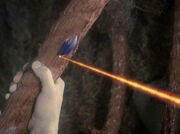mNo edit summary |
mNo edit summary |
||
| Line 1: | Line 1: | ||
[[Image:Surata_IV_thorn.jpg|thumb|[[Data]] and [[Geordi LaForge]] carefully extract a thorn from one of the large predatory vines of [[Surata IV]] using a phaser, in order to collect Surata microbes]] |
[[Image:Surata_IV_thorn.jpg|thumb|[[Data]] and [[Geordi LaForge]] carefully extract a thorn from one of the large predatory vines of [[Surata IV]] using a phaser, in order to collect Surata microbes]] |
||
| − | '''Surata microbes''' are contained in thorns on the large predatory vines of [[Surata IV]]. |
+ | '''Surata microbes''' are contained in thorns on the large predatory vines of [[Surata IV]]. They are designed to infect the [[nervous system]] of warm-blooded animals in order to enrich the soil surrounding the vines with the decaying remains following death. It is neither a virus nor a bacteria but has characteristics of both. |
| − | In [[2365]], [[Commander]] [[William Riker]] was attacked by one of the vines. |
+ | In [[2365]], [[Commander]] [[William Riker]] was attacked by one of the vines. The Surata microbes attached themselves to the great [[sciatic nerve]] and began multiplying, fusing themselves to the nerves at a molecular level. Conventional surgery and the transporter's biofilter were unable to remove the microbes, which were causing no damage but were impeding neural functions. This led to eventual paralysis and brain infection. The growth rate of the microbes doubled when exposed to [[endorphin|endorphins]] released by erotic dreams and decreased significantly when other chemicals were released by stimulated feelings of survival. ([[TNG]]: "[[Shades of Gray]]") |
[[Category:Medical conditions]] |
[[Category:Medical conditions]] |
||
Revision as of 16:04, 26 October 2006

Data and Geordi LaForge carefully extract a thorn from one of the large predatory vines of Surata IV using a phaser, in order to collect Surata microbes
Surata microbes are contained in thorns on the large predatory vines of Surata IV. They are designed to infect the nervous system of warm-blooded animals in order to enrich the soil surrounding the vines with the decaying remains following death. It is neither a virus nor a bacteria but has characteristics of both.
In 2365, Commander William Riker was attacked by one of the vines. The Surata microbes attached themselves to the great sciatic nerve and began multiplying, fusing themselves to the nerves at a molecular level. Conventional surgery and the transporter's biofilter were unable to remove the microbes, which were causing no damage but were impeding neural functions. This led to eventual paralysis and brain infection. The growth rate of the microbes doubled when exposed to endorphins released by erotic dreams and decreased significantly when other chemicals were released by stimulated feelings of survival. (TNG: "Shades of Gray")
